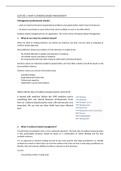College aantekeningen
Notes of Evidence Based Management
- Instelling
- Universiteit Van Amsterdam (UvA)
This is a summary of the course Evidence Based Management at the University of Amsterdam . The summary includes all the required lectures and tutorials
[Meer zien]





